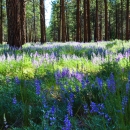States
OregonVoluntary conservation through Sage-Grouse Candidate Conservation Agreements with Assurances (CCAAs) support the ecological integrity and uplift of Oregon’s privately owned rangelands.
Voluntary conservation on privately-owned rangelands is a cornerstone of sagebrush sagebrush
The western United States’ sagebrush country encompasses over 175 million acres of public and private lands. The sagebrush landscape provides many benefits to our rural economies and communities, and it serves as crucial habitat for a diversity of wildlife, including the iconic greater sage-grouse and over 350 other species.
Learn more about sagebrush and sage-grouse conservation. Actions that maintain and improve sagebrush ecosystem health also benefit overall rangeland health, help sage-grouse and other wildlife species, and sustain ranching operations. Private ranchers steward sage-grouse habitat by providing large areas of continuous, high-quality habitat. The continued sustainability of ranching operations is central to preventing widespread habitat loss. In Oregon’s high desert environments, positive results from habitat restoration are often slow and conservation actions must be maintained over the long term to sustain benefits.
Oregon’s Sage-grouse CCAAs are long-term conservation agreements that operate at a ranch-wide scale to address and monitor all known threats to sage-grouse and their habitat, providing both comprehensive and durable benefits. The CCAA program leverages several conservation programs for enhancing and restoring private rangelands offered by the USDA Natural Resources Conservation Service and funders like the Oregon Watershed Enhancement Board. Together the CCAA program, along with these Federal and State organizations, have been successful in assisting landowners in improving rangelands to benefit wildlife and ranching operations. While over half a million acres of private lands have been enrolled in the CCAA program, there is still huge potential for scaling up these successes across the sagebrush landscape.
The CCAA program in Oregon officially started in 2014, when the greater sage-grouse was a candidate for listing under the Endangered Species Act. This provided an incentive to proactively manage for the benefit of sage-grouse and sagebrush rangeland health. A CCAA is a 30-year agreement between the U.S. Fish and Wildlife Service and a local entity, such as a Soil and Water Conservation District or Watershed Council. Properties enrolled under this program are assessed for risks to sage-grouse and their habitat (which are often the primary threats to overall sagebrush ecosystem health) and actions are identified to address those ecological concerns.
Enrollees voluntarily agree to certain conservation actions and work with their local District or Council to develop plans to promote rangeland health and sage-grouse populations. In exchange, these landowners are prioritized for funding assistance to complete conservation actions and are provided regulatory protections in the event of a future listing of sage-grouse under the Endangered Species Act. As part of the process, comprehensive site-specific plans are developed, priority actions are implemented to improve rangeland conditions, and threats to sage-grouse are decreased. Agreements are monitored and adaptively managed over the course of their 30-year duration to ensure durability of conservation actions over multi-decadal time frames.
The CCAA approach to long-term, whole-ranch conservation complements and facilitates coordination and collaboration across public and private boundaries toward the state’s vision of “all hands, all lands” sagebrush conservation.
Site-specific planning requires relationship-building and close collaboration with the enrolled landowners to understand current conditions and ecological concerns on the property, ensure continued economic viability of the ranching operation, and foster shared goals to benefit both the ranching operation and wildlife on the property.
Monitoring and adaptive management occur for the duration of the 30-year agreement, ensuring areas in need of management adjustments or re-treatment are addressed. The investments in site-specific, comprehensive, and long-term planning pays dividends over the long-term. In a system like the sagebrush steppe, change is slow, and ongoing management is needed to maintain progress towards improved ecological health and sage-grouse habitat condition.
Nearly 600,000 acres of sage-grouse habitat on private lands have been enrolled in CCAAs between 2015 and 2022 in Crook, Lake, Harney, Malheur, Baker, and Union counties. More than 100 additional landowners have committed to enroll, with the promise of adding nearly 1 million more acres to this total.
For more information:
Four eastern Oregon Soil and Water Conservation Districts and the Powder Basin Watershed Council each maintain Candidate Conservation Agreements with Assurances (CCAA) with the U.S. Fish and Wildlife Service to promote voluntary conservation of sage-grouse on private lands in southeastern Oregon:
- Crook Soil and Water Conservation District
- Harney Soil and Water Conservation District
- Malheur Soil and Water Conservation District
- Lakeview Soil and Water Conservation District
- Powder Basin Watershed Council
U.S. Fish and Wildlife Service contacts:
- Baker, Union, and Malheur counties: Jackie Cupples, jacqueline_cupples@fws.gov, or Julie Unfried, julie_unfried@fws, La Grande Field Office
- Crook, Deschutes, Harney, and Lake counties: Emily Weidner, emily_weidner@fws.gov, or Brian Wilk, brian_wilk@fws.gov, Bend Field Office


